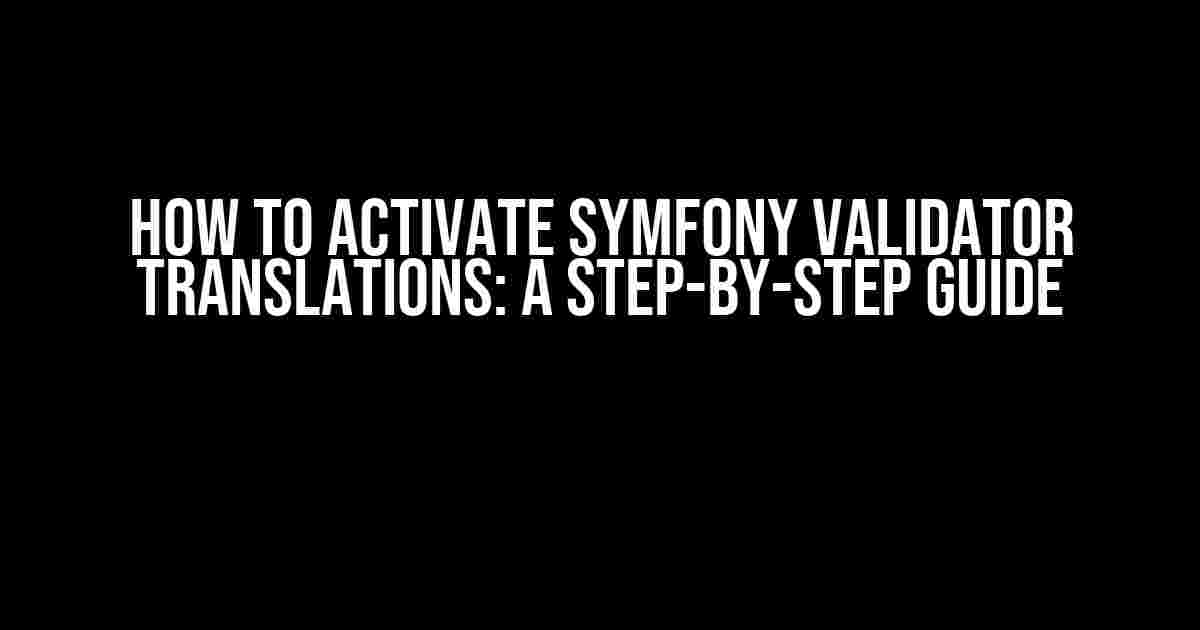Are you struggling to get Symfony validator translations up and running in your application? Look no further! In this article, we’ll take you through a comprehensive guide on how to activate Symfony validator translations. We’ll cover everything from the basics to advanced configurations, so buckle up and let’s dive in!
- What are Symfony Validator Translations?
- Why Activate Symfony Validator Translations?
- Step 1: Install the Symfony Validator Component
- Step 2: Configure the Validator Component
- Step 3: Create Translation Files
- Step 4: Update Your Form Type
- Step 5: Use the Translated Validator Messages
- Advanced Configuration: Using Multiple Translation Files
- Using Symfony Validator Translations with Doctrine
- Conclusion
What are Symfony Validator Translations?
Before we dive into the activation process, let’s quickly understand what Symfony validator translations are. In Symfony, validators are used to validate user input data. These validators can be translated to provide user-friendly error messages in different languages. Symfony validator translations allow you to define translations for these error messages, making your application more user-friendly and accessible to a global audience.
Why Activate Symfony Validator Translations?
Activating Symfony validator translations offers several benefits:
- Improved user experience: Provide users with error messages in their native language, making it easier for them to understand and correct errors.
- Increased accessibility: Make your application more accessible to users from diverse linguistic backgrounds.
- Enhanced localization: Take your application to the next level by providing localized error messages that align with your target audience’s language and cultural preferences.
Step 1: Install the Symfony Validator Component
To get started, you need to install the Symfony Validator component. You can do this using Composer:
composer require symfony/validator
Once installed, you can use the Validator component to define and validate your application’s input data.
Step 2: Configure the Validator Component
Next, you need to configure the Validator component to use translations. Create a new file `validator.yaml` in your `config` directory:
# config/validator.yaml
framework:
validator:
enabled: true
translations:
- { id: 'validators', path: '%kernel.project_dir%/translations/validators.%locale%.yml' }
In this configuration file, we’ve enabled the Validator component and specified the translation file path. The `{ id: ‘validators’, path: ‘%kernel.project_dir%/translations/validators.%locale%.yml’ }` line tells Symfony to look for translation files in the `translations` directory, with the filename format `validators.<locale>.yml`.
Step 3: Create Translation Files
Create a new directory `translations` in your project’s root directory, and add a new file `validators.en.yml` (or your preferred language code) with the following content:
# translations/validators.en.yml
constraints:
NotBlank:
message: 'This field is required.'
Email:
message: 'Please enter a valid email address.'
In this example, we’ve defined translations for the `NotBlank` and `Email` constraints. You can add more translations as needed.
Step 4: Update Your Form Type
To use the validator translations in your form type, update your form type class:
// src/Form/MyFormType.php
namespace App\Form;
use Symfony\Component\Form\AbstractType;
use Symfony\Component\Form\Extension\Core\Type\TextType;
use Symfony\Component\Form\FormBuilderInterface;
use Symfony\Component\OptionsResolver\OptionsResolver;
use Symfony\Component\Validator\Constraints as Assert;
class MyFormType extends AbstractType
{
public function buildForm(FormBuilderInterface $builder, array $options)
{
$builder
->add('name', TextType::class, [
'constraints' => [
new Assert\NotBlank([
'message' => 'validators.constraints.NotBlank.message',
]),
],
])
->add('email', TextType::class, [
'constraints' => [
new Assert\Email([
'message' => 'validators.constraints.Email.message',
]),
],
])
;
}
public function configureOptions(OptionsResolver $resolver)
{
$resolver->setDefaults([
'data_class' => MyEntity::class,
]);
}
}
In this example, we’ve updated the form type to use the `NotBlank` and `Email` constraints with their respective translations.
Step 5: Use the Translated Validator Messages
Finally, to use the translated validator messages, create a new controller action:
// src/Controller/MyController.php
namespace App\Controller;
use Symfony\Component\HttpFoundation\Request;
use Symfony\Component\HttpFoundation\Response;
class MyController extends Controller
{
public function createAction(Request $request)
{
$form = $this->createForm(MyFormType::class);
$form->handleRequest($request);
if (!$form->isValid()) {
$errors = $form->getErrors();
// Display error messages
foreach ($errors as $error) {
$message = $error->getMessage();
// ...
}
}
// ...
}
}
In this example, we’ve created a new controller action that handles form submissions. When the form is invalid, we retrieve the error messages and display them to the user.
Advanced Configuration: Using Multiple Translation Files
In some cases, you might need to use multiple translation files for different domains or categories. Symfony allows you to do this by specifying multiple translation files in the `validator.yaml` configuration file:
# config/validator.yaml
framework:
validator:
enabled: true
translations:
- { id: 'validators', path: '%kernel.project_dir%/translations/validators.%locale%.yml' }
- { id: 'category', path: '%kernel.project_dir%/translations/category.%locale%.yml' }
In this example, we’ve added two translation files: `validators` and `category`. You can define separate translations for each file.
Using Symfony Validator Translations with Doctrine
If you’re using Doctrine, you can also use Symfony validator translations with your entity constraints. Here’s an example:
// src/Entity/MyEntity.php
namespace App\Entity;
use Doctrine\ORM\Mapping as ORM;
use Symfony\Component\Validator\Constraints as Assert;
/**
* @ORM\Entity
* @ORM\Table(name="my_table")
*/
class MyEntity
{
/**
* @ORM\Column(type="string")
* @Assert\NotBlank(message="validators.constraints.NotBlank.message")
*/
private $name;
/**
* @ORM\Column(type="string")
* @Assert\Email(message="validators.constraints.Email.message")
*/
private $email;
}
In this example, we’ve added validator constraints to our entity properties, using the translated messages defined in our `validators.en.yml` file.
Conclusion
And there you have it! With these simple steps, you’ve successfully activated Symfony validator translations in your application. By following this guide, you’ve taken a significant step towards providing a more user-friendly and accessible experience for your users. Remember to explore the advanced configuration options and adapt them to your specific needs.
| Step | Description |
|---|---|
| 1 | Install the Symfony Validator component |
| 2 | Configure the Validator component to use translations |
| 3 | Create translation files for your validator constraints |
| 4 | Update your form type to use the translated validator messages |
| 5 | Use the translated validator messages in your controller action |
By following this comprehensive guide, you’ll be able to provide a more localized and user-friendly experience for your users. Remember to explore the advanced configuration options and adapt them to your specific needs.
Here are the 5 Questions and Answers about “How to activate Symfony validator translations” in a creative voice and tone:
Frequently Asked Question
Stuck with activating Symfony validator translations? We’ve got you covered! Check out our top 5 FAQs to get you started.
Q1: Why do I need to activate Symfony validator translations?
Activating Symfony validator translations allows you to display error messages in the user’s preferred language, providing a better user experience. This is especially crucial for multilingual applications where validation error messages need to be translated.
Q2: How do I enable the Symfony validator translator?
To enable the Symfony validator translator, you need to configure the `translator` service in your `config/translation.yaml` file. Set `translator.default_locale` to the default locale you want to use, and `translator.fallback_locale` to the fallback locale in case the translation is not found.
Q3: Where do I put my validator translation files?
Place your validator translation files in the `translations` directory, following the ` validators.[locale].yaml` naming convention (e.g., `validators.en.yaml` or `validators.fr.yaml`). These files should contain the translated error messages for each validator.
Q4: Can I use other translation services like gettext or messages?
Yes, you can use other translation services like gettext or messages. Symfony supports multiple translation services out of the box. However, for validator translations, the built-in translator service is recommended, as it provides a straightforward way to manage translations.
Q5: How do I test my validator translations?
To test your validator translations, create a test case that submits an invalid form with a specific locale set. Then, verify that the error messages are displayed in the correct language. You can use a testing framework like PHPUnit or a tool like Cypress to automate this process.




